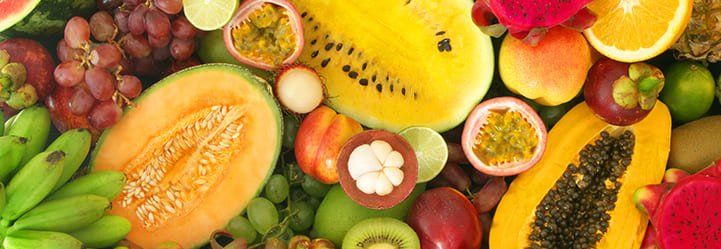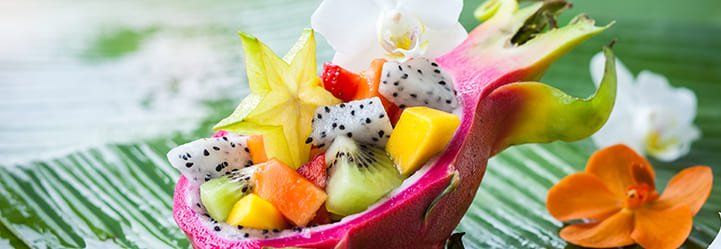Tropical fruits: their benefits and uses in the food industry
Alimentos SAS • May 05, 2021

Many of us have purchased tropical fruits from the local supermarket. Tropical fruits like mangos or bananas are quite run-of-the-mill these days. Whereas durians and mangosteens are still novel to most of us living outside of the tropics.
Tropical fruits are any fruits produced by a tree native to the tropics. The tropics could be defined as the region of the globe between the Tropic of Cancer and the Tropic of Capricorn (McMahon, M., 2021). Various tropical fruits are in high demand in many countries around the globe.
So, you may not have heard of less common tropical fruits like Abiu – yellow star apple – or Chikoo, but let’s introduce you to some of the most popular tropical fruits. You may be surprised at how many you recognize! Learn about their origins, nutritional benefits, and what food and drink products they can be used in.
Top tropical fruits
No. 1 on the list of tropical fruits is Durian – “king of the fruits”
This stinky fruit, described as tasting like onion ice cream by some, grows throughout Southeast Asia. It is spikey on the outside and creamy and custard like on the inside. Many hotels in South East Asia have “no durian” signs because the fruit has such a pungent smell.
Durian is a superfood. It is highly nutritious, full of vitamins and minerals and dietary fiber, and filled with antioxidants. It is also packed with tryptophan – an essential amino acid which is metabolized into serotonin and melatonin.
There are a lot of recipes from Southeast Asia which incorporate Durian – like Durian cheesecake. It can also be used in juices, ice cream, and shaved ice.
Guava (Psidium Guajava)
This sweet and granular-textured fleshy fruit is native to tropical America. Now, it is grown in many other tropical parts of the world.
Guava is a super source of essential nutrients like vitamin C, iron, calcium, and phosphorus.
Guavas can be canned and used in desserts. They can also be used in jams, juices, and purees.
Mangosteen – purple mangosteen or “the queen of the fruits”
This sweet and slightly tart fruit originates from the Sunda Islands – now divided between Indonesia, Malaysia, Brunei, and East Timor. It is also the national fruit of Thailand. It has a dark purple hard shell which incases soft and juicy white segments.
This is one of the tropical fruits with a bucket load of benefits. Among many other benefits, it is highly nutritious and contains powerful antioxidants. Some of the things it is used for are stimulating the immune system and improving mental health.
It can be used in ice creams, sorbets, and many other desserts
Rambutans
One of the more playful looking tropical fruits, this aromatic fruit is native to Malaysia. It is now commonly cultivated all over Southeast Asia.
The skin of the Rambutan varies in color but is always covered with tubercles that look like the plastic bristles on a hairbrush. It also looks a bit like a sea urchin. The fruit has the same sweetness as lychee, but is more acidic and is an excellent source of vitamin C.
It can be used in smoothies, 100% juice applications, ice creams, sorbets, etc.
Mamey Sapote
This fruit is native to Mexico and Central America but grown throughout tropical America and in some countries in Southeast Asia. It is also cultivated in the Caribbean. It is eaten mainly in Latin American countries.
The fruit is a soft, sweet, creamy pulp surrounded by rough skin. It tastes like a combination of pumpkin and sweet potato.
It is another one of the tropical fruits which is a powerhouse of vitamins, minerals, and other nutrients.
It can be made into foods such as milkshakes, smoothies, and ice creams.
Dragon fruit – ‘Honolulu queen’
The fruit grows on the Hylocereus cactus and is native to southern Mexico and Central America
This exotic looking fruit looks something like an artichoke, it’s pointy scales like that on a dragon. It comes in four varieties:
- Pink-skinned with white flesh
- Pink-skinned with red flesh
- Pink-skinned with purple flesh
- Yellow-skinned with white flesh
Each variety has tiny black seeds that are edible, like a kiwifruit.
The fruit contains prebiotics and is high in antioxidants and fiber.
It can be used in cocktails, fresh juices, smoothies, and ice cream.
Tropical fruits are becoming more and more popular in the food industry. There are also so many ways in which to use them. With advances in packaging options, like aseptic packaging, and innovations in food processing technology, exotic tropical fruits are going to become increasingly popular on foreign supermarket shelves. Consumers are looking for the unusual as most of them are bored with the common.















